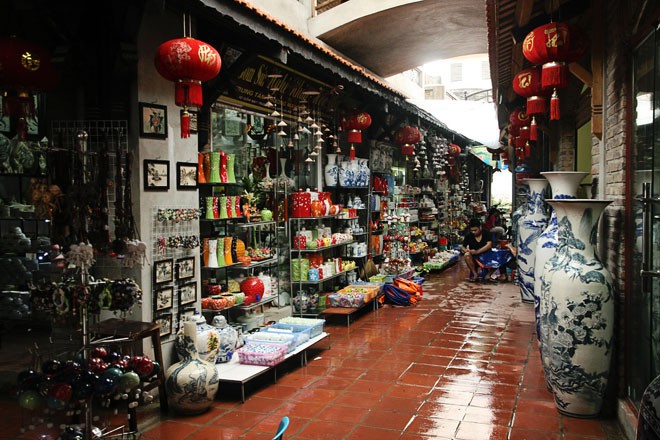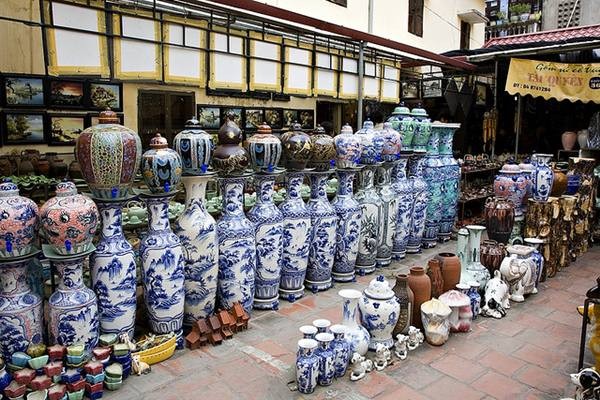1. Location & History of Bat Trang Ceramic Village

- Where: Bat Trang Village, Gia Lam District, Hanoi
2. Do You Need to Pay to Enter Bat Trang Ceramic Village?
 One of the best things about visiting Bat Trang Ceramic Village is that it doesn’t cost anything to explore. You can wander through the old streets, visit the market, and watch artisans at work without paying an entrance fee.The only time you’ll need to spend money is if you decide to join a pottery-making class, buy some ceramics, or stop for a meal at one of the village’s cozy restaurants. The ticket for a pottery experience is often about 30,000 – 70,000 VND for adults and from 20,000 to 50,000 VND for children. This makes Bat Trang a perfect destination for travelers on any budget.
One of the best things about visiting Bat Trang Ceramic Village is that it doesn’t cost anything to explore. You can wander through the old streets, visit the market, and watch artisans at work without paying an entrance fee.The only time you’ll need to spend money is if you decide to join a pottery-making class, buy some ceramics, or stop for a meal at one of the village’s cozy restaurants. The ticket for a pottery experience is often about 30,000 – 70,000 VND for adults and from 20,000 to 50,000 VND for children. This makes Bat Trang a perfect destination for travelers on any budget.3. How to Get to Bat Trang Ceramic Village from Hanoi
Getting to Bat Trang Ceramic Village from Hanoi is easy, and you have a few different options depending on how you like to travel.If you want the cheapest way, take bus number 47A or 47B from Long Bien Bus Station. The ride takes about 30 minutes, and you’ll get to see everyday life in Hanoi as you travel. For more freedom, renting a motorbike or taking a taxi is a good choice. The drive is simple – just follow the road along the Red River, and you’ll reach the village in 20 to 30 minutes.For a special experience, try the boat trip on weekends. Sailing down the Red River gives you beautiful views of the countryside before arriving at Bat Trang. The boat ride costs between 300,000 and 400,000 VND, but it’s a relaxing and scenic way to start your visit.4. The Best Places to See in Bat Trang Ceramic Village
4.1 Bat Trang Ancient Village
 Bat Trang Ceramic Village is full of interesting activities, and you can easily spend a whole day here without getting bored. One of the first places to visit is the old part of the village, where narrow lanes wind between traditional houses. Many of these homes have been turned into small workshops where families still make pottery using techniques passed down for generations.
Bat Trang Ceramic Village is full of interesting activities, and you can easily spend a whole day here without getting bored. One of the first places to visit is the old part of the village, where narrow lanes wind between traditional houses. Many of these homes have been turned into small workshops where families still make pottery using techniques passed down for generations.4.2 The Bat Trang Ceramic Market
 The Bat Trang Ceramic Market is another must-see. With over 100 stalls, the market is a rainbow of handmade bowls, cups, vases, and decorative items. Whether you’re looking for an authentic Bat Trang ceramic shop or a special piece of art, you’ll find it here. The best part? You can often watch the artisans at work, shaping clay into beautiful objects right before your eyes.
The Bat Trang Ceramic Market is another must-see. With over 100 stalls, the market is a rainbow of handmade bowls, cups, vases, and decorative items. Whether you’re looking for an authentic Bat Trang ceramic shop or a special piece of art, you’ll find it here. The best part? You can often watch the artisans at work, shaping clay into beautiful objects right before your eyes.4.3 Making Pottery
 If you’ve ever wanted to try making pottery yourself, Bat Trang Ceramic Village is the perfect place. Many workshops offer short classes where you can learn to shape clay on a traditional wheel. The teachers are patient and skilled, and even beginners can create something to take home. After you finish, your pottery will be fired in a kiln, and you can pick it up later or have it shipped to your home.
If you’ve ever wanted to try making pottery yourself, Bat Trang Ceramic Village is the perfect place. Many workshops offer short classes where you can learn to shape clay on a traditional wheel. The teachers are patient and skilled, and even beginners can create something to take home. After you finish, your pottery will be fired in a kiln, and you can pick it up later or have it shipped to your home.4.4 Bat Trang Ceramic Museum
5. Enjoy the Cuisine in Bat Trang Ceramic Village
Along the streets of Bat Trang pottery market, visitors can easily find many eateries with typical dishes at affordable prices. Visitors should try combining many dishes to fully experience the flavor of Bat Trang cuisine. Some famous dishes here are:
- Steamed Rice Cake (Banh Te): Cakes are made from finely ground rice with minced meat, wood ear mushrooms, and shiitake mushrooms, served with sweet and sour fish sauce. The price is about 5,000-10,000 VND/piece.
- Grilled cassava cake: Crispy crust, fragrant grilled smell, grilled directly on hot coals. Price is 15,000-20,000 VND/piece.
- Bamboo shoots and squid soup: Crispy bamboo shoots and chewy, sweet squid are extremely delicious and a must-try dish when coming to Bat Trang Pottery Village.
6. Helpful Tips for Visiting Bat Trang Ceramic Village
To make the most of your trip to Bat Trang Ceramic Village, keep a few simple tips in mind. The roads to Bat Trang Ceramic Village can be dusty, so wearing sunscreen and bringing a hat or scarf is a good idea if you’re riding a motorbike. When walking through the village, remember that Bat Trang is both a tourist destination and a place where people live and work. Dressing modestly and being respectful of the local customs will make your visit more enjoyable for everyone. In the market, be careful when handling the pottery – some pieces are delicate, and the aisles can be narrow.
When walking through the village, remember that Bat Trang is both a tourist destination and a place where people live and work. Dressing modestly and being respectful of the local customs will make your visit more enjoyable for everyone. In the market, be careful when handling the pottery – some pieces are delicate, and the aisles can be narrow.Final Thoughts
Bat Trang Ceramic Village is a perfect day trip from Hanoi. Whether you want to buy unique ceramics, try pottery-making, or explore Vietnamese culture, this village has it all. With no entrance fee to the village and easy transportation, it’s a must-see for travelers! >>> Interest in a Cultural Explorer tour near Hanoi? Check out our Hanoi Cultural Heritage Tour at Ba Duong Noi Village!
With YESD Vietnam, your visit to Bat Trang Ceramic Village becomes even more meaningful. As a responsible tour operator, YESD connects you directly with a local tour guide and ensures that your trip supports the preservation of traditional craft and the well-being of local communities in Vietnam. Whether you want to learn the full story behind a single teacup or dive deeper into Vietnam’s intangible heritage, a YESD tour is your gateway to an authentic, ethical, and enriching exploration.
Plan your visit to Bat Trang Ceramic Village today and take home a piece of Vietnam’s pottery heritage!
>>> Interest in a Cultural Explorer tour near Hanoi? Check out our Hanoi Cultural Heritage Tour at Ba Duong Noi Village!
With YESD Vietnam, your visit to Bat Trang Ceramic Village becomes even more meaningful. As a responsible tour operator, YESD connects you directly with a local tour guide and ensures that your trip supports the preservation of traditional craft and the well-being of local communities in Vietnam. Whether you want to learn the full story behind a single teacup or dive deeper into Vietnam’s intangible heritage, a YESD tour is your gateway to an authentic, ethical, and enriching exploration.
Plan your visit to Bat Trang Ceramic Village today and take home a piece of Vietnam’s pottery heritage!